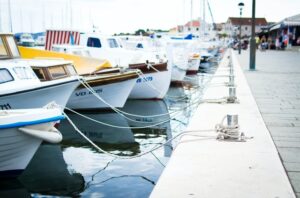 Boat windshields are a lot different from what you see on homes and cars. Sailboats, when they are out at sea, need to withstand heavy waves, high winds, and the salty seawater. Because of these elements, the windows may weaken and suffer from water damage. This means that the materials will need to be stronger and the overall windshield will need to be tough. And this is where the different types of materials for marine glass comes in.
Boat windshields are a lot different from what you see on homes and cars. Sailboats, when they are out at sea, need to withstand heavy waves, high winds, and the salty seawater. Because of these elements, the windows may weaken and suffer from water damage. This means that the materials will need to be stronger and the overall windshield will need to be tough. And this is where the different types of materials for marine glass comes in.
Not all boat windshields are built the same way. Some feature materials that are sturdier than others in certain applications. That means you can’t choose a one-size-fits-all windshield, because they might fail for a job they’re not made for. So let’s sail on and take a look at the most common materials used for aftermarket boat windshields.
Related: DIY Boat Restoration in 5 Easy Steps
Types Of Materials
There are three basic types of materials used for marine window or windshield. Here’s a quick look at each of them:
- Acrylic: This type of marine window isn’t made of glass, but with a special type of plastic. Also known as “organic glass,” acrylic is a semi-rigid window option. That means you can bend it to a certain degree without breaking. This is one of the most commonly used materials in marine applications, for reasons that will be explained further.
- Glass: This is a bit closer to windows in homes that people are more familiar with. It’s another popular choice for use on custom boat windshields, mainly due to their versatility.
- Polycarbonate: This is made from a semi-rigid clear plastic that is durable enough to be considered unbreakable. It can withstand far more punishment on the water than almost anything else, but that comes at a price.
What Are The Advantages Of Each?
As previously discussed, each aftermarket boat windshield or window material has its own advantages. Read on to learn more about what each material can do, and when they’re best applied.
- Acrylic is much like polycarbonate because it’s semi-rigid. Again, this allows for a certain degree of bending, which makes it great for following a boat’s contours. As you may know, boats don’t always have straight lines. Going for an acrylic windowpane will make installing windows easier. Another thing about acrylic is it’s also incredibly durable. They’re very strong; strong enough in fact that they’re hard to break. This makes them perfect for rugged environments, like the open ocean. Lastly, acrylic is naturally UV resistant, so there’s no need for extra coating to protect yourself from harmful UV rays.
- Glass is easier to find, and sometimes even cheaper than non-glass alternatives. Many praise glass for its overall versatility, because you can install it anywhere on a boat. Side windows, deck windows, even on the bridge – it doesn’t matter. There is always a glass option for every specific installation location on a boat. And since glass can also be custom-shaped, you don’t have to bend it. You can have it custom-ordered to fit a specific boat model, and nothing else.
- Polycarbonate is a type of clear plastic that is unbreakable. If you want windows that can withstand anything short of a bullet, this is the material to go for. It also offers the best visibility, which makes them ideal for windows in the first place. Because what is the purpose of a window if you can’t see out of it anyway? Not to mention, you can also coat it with UV-resistant and scratch-resistant film for added protection.
 Coated Or Uncoated?
Coated Or Uncoated?
Windows and windshields are prone to getting scratched. They’re also vulnerable to letting UV rays in, as previously stated. As such, mariners also have the choice to go for either coated or uncoated windows.
Technology is advanced enough now that coated windows are often the best options out there. The fact that these windows are coated means they’re protected from a wide variety of issues. A huge one of which is scratching. Imagine this: how can you enjoy the outside scenery if you have to look through scratches? With the right coating, scratches will never be a problem.
But perhaps the biggest issue with uncoated boat windshields/windows is protection from the sun. When sailing, you’re at the mercy of its rays. UV rays, to be specific. And not only could it damage your skin, but also the windows. In fact, clear plastic surfaces are very much prone to UV ray damage. The sun evaporates the surface’s plasticizers, which makes them brittle. And if the surface becomes brittle, then it can break.
Which One Should You Go For?
Despite all of this information, there’s only one thing certain at the end of the day. It’s your choice! If you own a boat, it is up to you to determine what works well for it and what doesn’t. That also applies to choosing the right aftermarket boat windshields and windows. Consider your needs and wants against cost, durability, and longevity, and you might have just done yourself a favor. It’s really that simple.
Related: Do’s & Don’ts: DIY Replacing Boat Windshields
We Can Help You With Your Custom Boat Windshield Needs!
If you’re still confused about which material for your windshield to pick, we can help you out. Here at Peninsula Glass, we fabricate flat glass boat windshields and have several of the best professionals in the business ready to answer your every query. Talk to us today!
